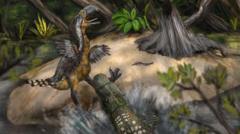Teeth imprints found on a large leg bone of the ancient terror bird, an avian predator towering at over 2.5 meters, indicate it was likely killed by a larger predator, a caiman-like reptile, approximately 13 million years ago, according to researchers. These terror birds, formidable hunters equipped with powerful legs and hooked beaks, once thrived in the humid swamps of what is now Colombia.
Publishing their findings in the journal Biology Letters, scientists conducted 3D scans of the teeth marks on the fossilized bone to compare them against the skulls and teeth of extinct crocodilian species preserved in museums. This investigation presents a rare insight into the interactions between two dominant predators of the time.
The leg bone, unearthed in the Tatacoa Desert over 15 years ago, reflects an era when the region was a rich habitat for various species. Lead researcher Andres Link from the Universidad de Los Andes in Bogotá noted the absence of healing signs in the bite marks, implying that if the terror bird wasn’t already dead when attacked, it succumbed moments later. "That was the last day that bird was on this planet," Link explained.
The analysis determined that the tooth marks closely resemble those of “Purussaurus neivensis,” a gigantic caiman that could reach lengths of up to five meters. Much like modern-day crocodiles, this ancient predator likely ambushed prey near the water's edge, making it a fearsome competitor for the terror bird.
The work began with fossil collector César Augusto Perdomo, who discovered the leg bone. Over the years, Perdomo and the scientists studied his collection, leading to significant findings about these rare terror bird fossils. Dr. Link expressed fascination at how fossilized remnants can provide insights into long-lost ecosystems, emphasizing the importance of every piece of evidence in reconstructing past lives on Earth.
As this analysis progresses, it reveals that these once-feared terror birds were more susceptible to predation than previously believed, altering our understanding of their ecological role before their extinction.



















